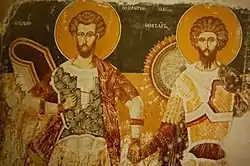Great martyr
A great martyr (also spelled greatmartyr or great-martyr) or megalomartyr (from Byzantine Greek μεγαλομάρτυς, megalomártus, from μέγας, mégas 'great' + μάρτυς, mártus 'martyr'; Church Slavonic: великомꙋ́ченикъ; Romanian: mare mucenic; Georgian: დიდმოწამე) is a classification of saints who are venerated in the Eastern Orthodox Church and those Eastern Catholic Churches which follow the Rite of Constantinople. The term is also used in Malta especially by parishes dedicated to Saint George in reference to him (San Ġorġ Megalomartri).

Generally speaking, a greatmartyr is a martyr who has undergone excruciating tortures—often performing miracles and converting unbelievers to Christianity in the process—and who has attained widespread veneration throughout the Church. These saints are often from the first centuries of the Church, before the Edict of Milan. This term is normally not applied to saints who could be better described as hieromartyrs (martyred clergy) or protomartyrs (the first martyr in a given region).
Partial list of megalomartyrs
- Saint Anastasia
- Saint Apostolos of St. Laurence
- Saint Artemius
- Saint Barbara
- Prince Bidzin, Prince Elizbar, and Prince Shalva of Georgia
- Saint Catherine of Alexandria
- Saint Christina
- Saint Demetrius
- Saint Euphemia
- Saint Eustace
- Saint George
- Saint George the New at Sophia (1515)
- Saint Haralambos
- Saint Irene
- John the New of Suceava
- Ketevan, Queen of Georgia
- Kostanti-Kakhay, of Georgia
- Saint Lazar of Serbia
- Saint Marina
- Saint Menas
- Saint Mercurius
- Saint Michael-Gobron of Georgia
- Saint Pantaleon
- Saint Paraskeva
- Saint Kyriaki
- Saint Phanourios
- Saint Procopius
- Saint Sabbas the Goth
- Theodore Gavra of Atran in Chaldea
- Saint Theodore Stratelates
- Theodore Tiron
- Saint Tryphon
- Xenia of Peloponnesus